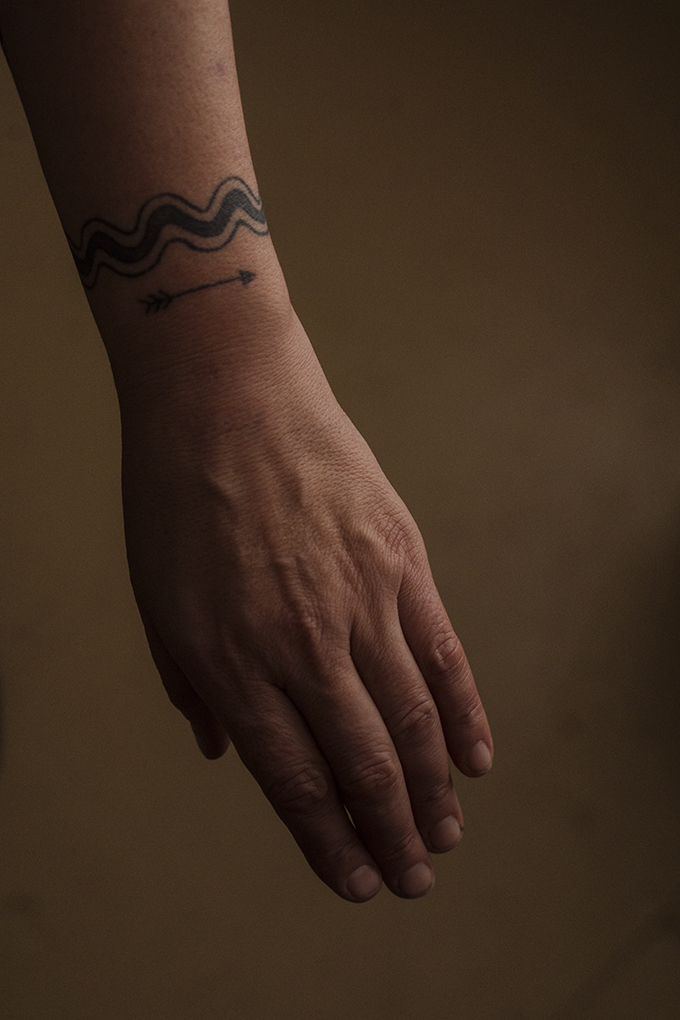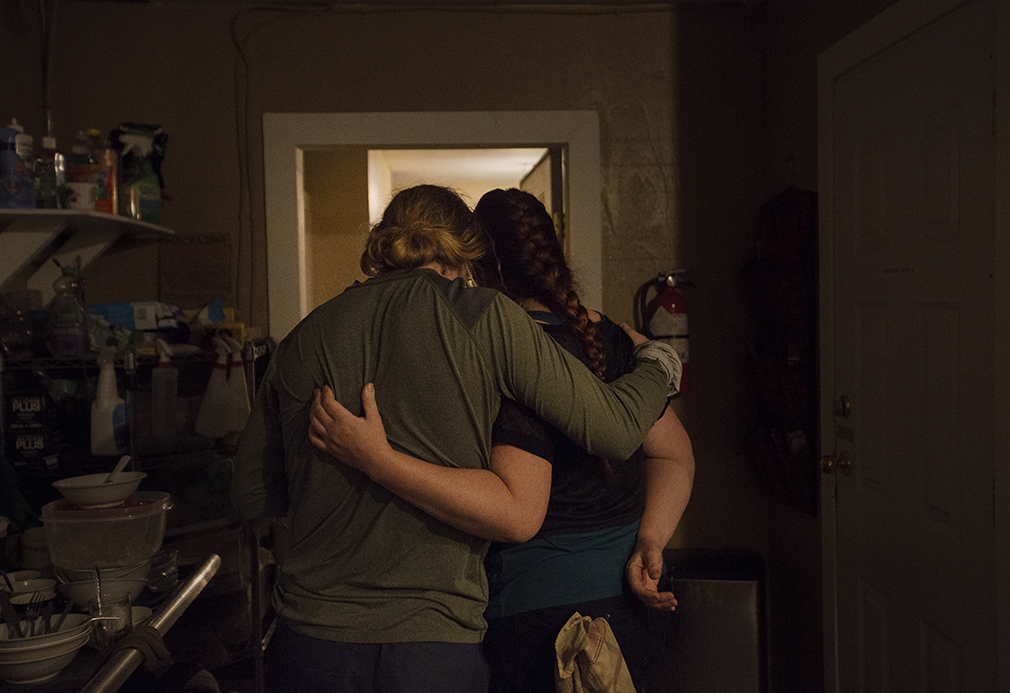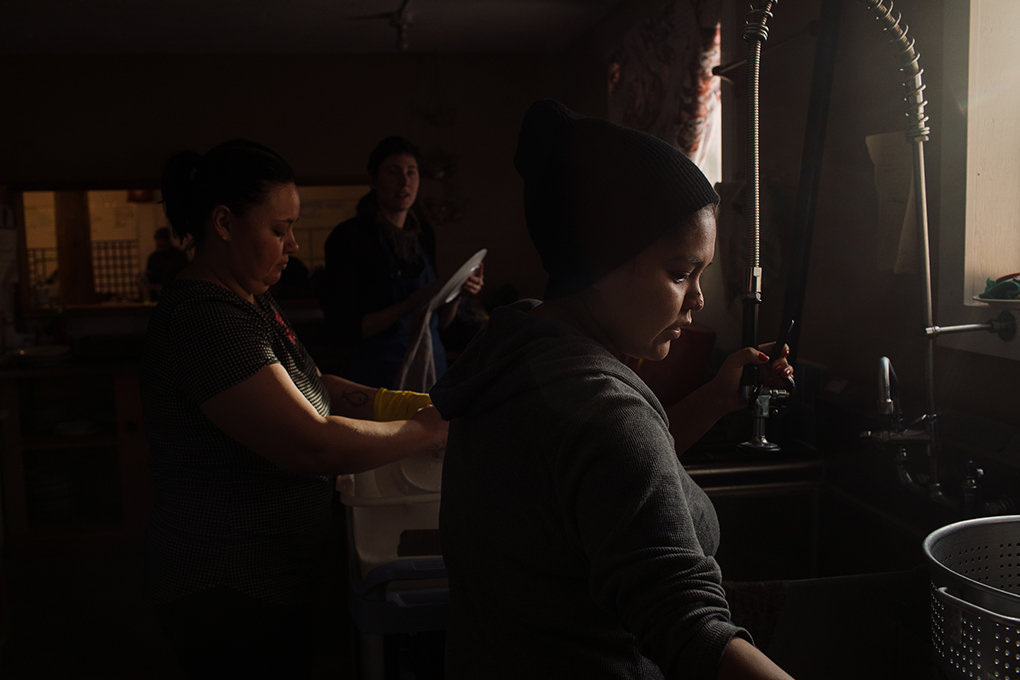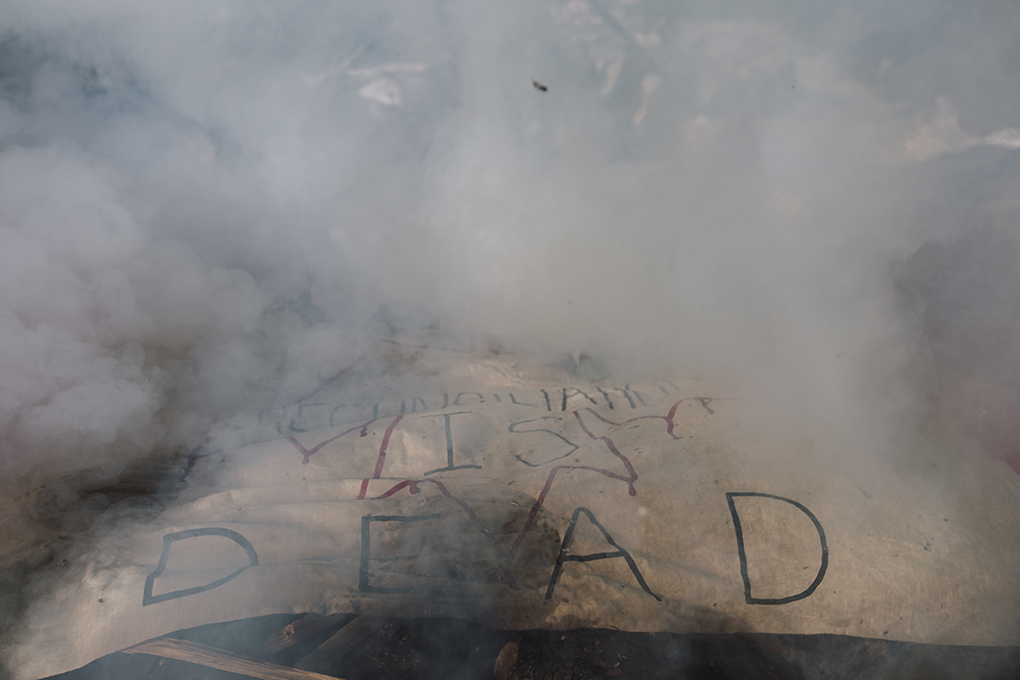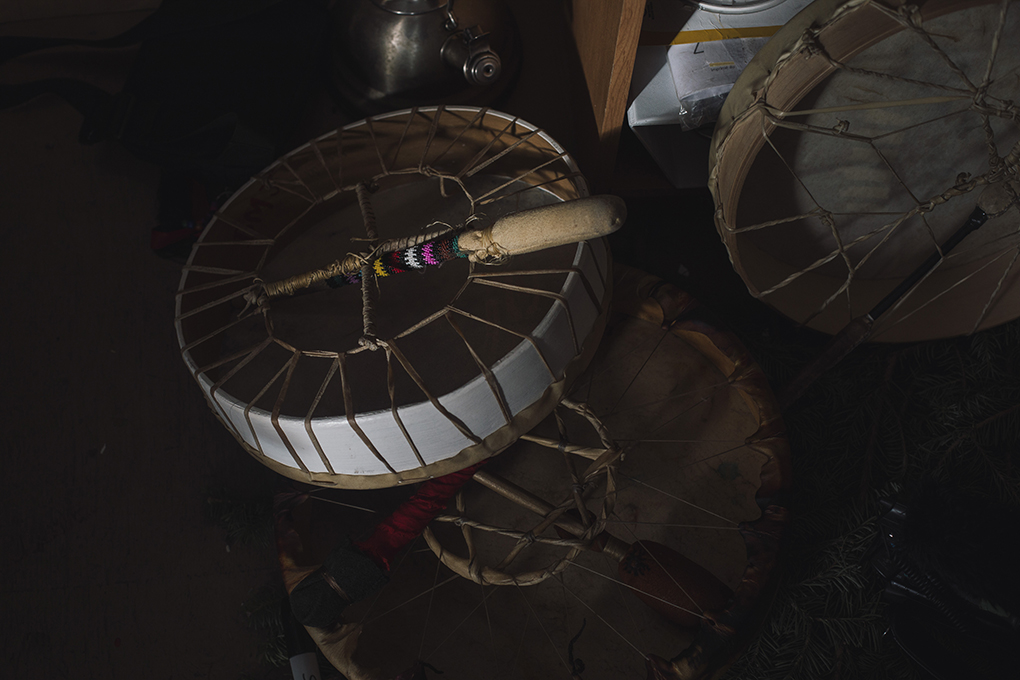
Photography sponsored by Digital 55.
The Language of Dispossession: Indigenous Defenders Against Pipelines
“What we’re doing here is protecting our critical infrastructure,” Freda Huson, Unist’ot’en spokesperson, told the documentarians who came to Unist’ot’en Village.
In Wet’suwet’en territory, in so-called northern British Columbia, Canada, members of the Dark House and Gilseyhu (Big Frog) Clan have built a permanent encampment. They live in the pathway of numerous potential and proposed pipelines that would run through the house group’s best berry patches.
The Canadian government characterizes these pipelines as “critical infrastructure:” “processes, systems, facilities, technologies, networks, assets, and services essential to the health, safety, security, or economic well-being of Canadians and the effective functioning of government[.] Disruptions of critical infrastructure could result in catastrophic loss of life, adverse economic effects, and significant harm to public confidence.” Indigenous food systems are not considered in the Canadian government’s definition, despite being essential to the health and well-being of Indigenous peoples.
Huson challenges the idea that pipeline infrastructures benefit Indigenous lives and futures. When she talks about our critical infrastructures, she is referring to a very different set of processes, systems, and networks that are embedded in relationships to the land that her family has cared for over many generations.
When Huson says “critical infrastructure,” she means the mutual relations between humans, animals, plants, and other beings that sustain Indigenous life. This network stands in stark contrast to the critical infrastructures of government and industry.
I asked Freda to describe the difference between industry ideas of critical infrastructure and the infrastructures that sustain Indigenous life on Unist’ot’en yintah (territory). “So industry and government always talk about critical infrastructure, and their critical infrastructure is making money, and using destructive projects to make that money, and they go by any means necessary to make that happen,” she told me. “So for us, our critical infrastructure is the clean drinking water, and the very water that the salmon spawn in, and they go back downstream and four years, come back. That salmon is our food source, it’s our main staple food. That’s one of our critical infrastructures. And there’s berries that are our critical infrastructure, because the berries not only feed us, they also feed the bears, and the salmon also don’t just feed us, they feed the bears. And each and every one of those are all connected, and without each other, we wouldn’t survive on this planet…for example, the bears will eat the berries and they’ll drop it, and the waste that comes out of the bear, it’s got seeds in it, so that germinates and we get more berries. We need the bears in order to keep producing our berries, and same with the salmon. The bears eat the salmon as well because once the salmon spawn, they end up dying anyways, and that becomes food for the bears, so it’s not being wasted.
“All of that is part of the system that our people depend on, and that whole cycle and system is our critical infrastructure, and that’s what we’re trying to protect, an infrastructure that we depend on. And industry and government are pushing these projects that would destroy that critical infrastructure, most important to our people.”**
When Huson says “critical infrastructure,” she means the mutual relations between humans, animals, plants, and other beings that sustain Indigenous life. This network stands in stark contrast to the critical infrastructures of government and industry. By introducing a different, contrasting sense of the word “infrastructure,” she brings attention to a crucial fact: industrial infrastructures do not create or support life. They are fundamentally at odds with the cycles and systems that make Indigenous survival possible.
Infrastructure
As an Indigenous anthropologist, I pay attention to the categories and analyses that the settler state uses to exercise authority and violence over Indigenous peoples. The government uses the language of “critical infrastructure” to make oil and gas infrastructure projects into crucial matters of national interest. These oil and gas infrastructures—and pipelines in particular—link industrial expansion with colonial occupation of Indigenous lands. They come with increased policing, industrial traffic, man camps, and environmental destruction. All of these effects make it difficult for Indigenous people to hunt, gather foods and medicines, and simply live in balance with the land. Pipelines solidify colonial power while threatening Indigenous ecologies. Even when functioning properly (without spills or breakdowns), pipelines damage the connections between Indigenous people and the land they care for. The relations between Indigenous people and lands include economic relations— the lands provide food, shelter, and medicine that meet human needs. When oil and gas infrastructures disrupt these relations, ecologies and economies are threatened, and Indigenous ways of life suffer.
Despite the damaging effects of oil and gas infrastructures, they are often hailed as signs of modern “progress.” When Indigenous people resist their construction, we are painted as backwards or savage, and our relations to the land and our animal kin are trivialized. But Indigenous systems are not only in the past; we are building relations that will help us survive the effects of catastrophic climate change, that will help build a livable future. This work of future-building is difficult when oil and gas infrastructures are considered normal and necessary. We can imagine a good life without them because our people lived without them before colonization. And this is the tension: for Indigenous people, pipeline infrastructures are an extension of colonization itself. If oil and gas infrastructures are “critical,” they are critical to the continued invasion and occupation of Indigenous lands. Indigenous resistance to oil and gas infrastructures protects our relations against the violence of that invasion and opens alternatives for living in good relation to our territories.
In the lands now occupied by Canada, the state’s approach to Indigenous protest has shifted under Prime Minister Justin Trudeau’s government. Trudeau’s government offers surface-level celebration of our cultures and aesthetics as a form of “reconciliation.” Meanwhile, Indigenous political orders, governance structures, and relations to our territories are ignored and our land continues to be stolen and destroyed. On National Aboriginal Day in 2016, the Trudeau government said, “No relationship is more important to our government and to Canada than the one with Indigenous peoples. Today, we reaffirm our government’s commitment to a renewed nation-to-nation relationship between Canada and Indigenous peoples, one based on the recognition of rights, respect, trust, co-operation, and partnership.”
Despite these statements of “recognition,” Indigenous peoples remain in a deeply subordinated relationship to Canada. Indigenous political claims to land and self-governance are repeatedly dismissed; meanwhile, oil and gas infrastructures continue to operate as signs of national progress and resource wealth. Resource extraction is called “critical” to national well-being and is normalized as unavoidable common sense. In 2017, at a keynote address to a meeting of oil and gas executives in Houston, Texas, Trudeau said that “no country would find 173 billion barrels of oil in the ground and just leave them there.” His speech was met with a standing ovation.
To be clear: RCMP arrived with seventy armed officers to remove four unarmed Indigenous land defenders from the territory. They pointed snipers at us.
The naturalization of oil and gas extraction and the framing of pipelines as “critical infrastructures” link industry profits to national security. This criminalizes Indigenous dissent and recasts destructive infrastructure projects as common sense and for the common good. As concern over the climate crisis increases, the Trudeau government has had to walk a fine line, promoting a “green transition” toward more sustainable sources of energy without cutting ties with Canada’s powerful oil and gas industry. Ironically, Canada has pledged to move toward net-zero carbon emissions by the year 2050 and to transition to green energy—but they intend to use revenue from oil and gas pipelines to fund the transition.
Indigenous people who resist pipeline expansion are positioned as not only anti-industry but also as (sometimes literal) roadblocks to a greener future. How, then, does the state deal with Indigenous resistance to critical infrastructures like pipelines?
Critical Infrastructure
I visited Unist’ot’en Village for the first time in the summer of 2015. I responded to their call for support on the ground after increased industry pressure and police presence threatened to breach the borders of their territory to begin construction of pipelines on their land. The atmosphere at the camp was tense. For the first few days, I sat by the fire alone, feeling the distrust and fear in the gaze of the Indigenous peoples gathered. In a matter of weeks, these people would grow to be my dearest friends, but in those first tense and heated days, they could not afford to trust a stranger.
In May of that year, the Canadian legislature had passed Bill C-51, which redefined “activity that undermines the security of Canada” as “any activity…if it undermines the sovereignty, security, or territorial integrity of Canada or the lives or the security of the people of Canada.” Activities explicitly listed include—in addition to terrorism, interference with public safety, and interference with Canada’s economic stability—“interference with critical infrastructure.” The Canadian government defines critical infrastructure as “the processes, systems, facilities, technologies, networks, assets and services essential to the health, safety, security or economic well-being of Canadians and the effective functioning of the government.” The United States operates under a similar definition of critical infrastructure as “systems and assets, whether physical or virtual, so vital to the United States that the incapacity or destruction of such systems and assets would have a debilitating impact on security, national economic security, national public health or safety, or any combination of those matters.” Canada and the United States also coordinate to protect and maintain cross-border critical infrastructures that permit the flow of goods, capital, and people between the two countries.
The discourse of critical infrastructure is tightly linked to national security and economic well-being. Canadian law understands oil and gas pipelines as critical infrastructure because both the United States and Canada rely on revenue from fossil fuels. Threats to pipeline projects, then, are cast as threats to national (economic) security. These definitions of critical infrastructure make it possible to place resistance to fossil fuels in the same category as domestic terrorism. Despite the fact that the re-occupation of traditional territory at Unist’ot’en Camp has always been peaceful, supporters in 2015 worried that they could be branded as terrorists simply by helping Wet’suwet’en people to re-establish a home on the territory they have cared for for thousands of years.
Invasion
For three years, I lived in the proposed construction footprint of the Coastal GasLink (CGL) fracked gas pipeline on Wet’suwet’en territory. The pipeline is not the first infrastructure to invade Wet’suwet’en lands. In 1913, the town of Smithers was built as a stop along the Grand Trunk Pacific Railway, and local Wet’suwet’en people were moved to the reservations and/ or continuously displaced as space was made for settlers on the newly occupied lands. Now, the territory is bisected by Highway 16, the “Highway of Tears,” known primarily for the numbers of Indigenous women who have gone missing and been murdered along its shoulders.
In November, 2018, the Coastal GasLink Pipeline company, a division of TC energy (formerly TransCanada, the company behind the Keystone XL pipeline) obtained an interim court injunction allowing them access to Dark House territory in order to begin pipeline construction. The injunction demanded that blocks to access for CGL be removed, including the gate over the Wedzin Kwa (Morice River) bridge that had served as the boundary protecting Unist’ot’en Village from trespassers and unauthorized industrial activity. The injunction effectively denied Dark House members and chiefs the right to determine proper use of their territories and accommodated CGL construction timelines at the expense of Indigenous jurisdiction over lands that have never been surrendered, ceded, or sold to a colonial government. Police raided the territory on January 4, 2019, and construction on the pipeline began shortly after.
From 2018 on, through the use of injunctions, the courts would authorize the invasion of Wet’suwet’en territory through police raids on a number of Wet’suwet’en checkpoints, the arrest of dozens of land defenders and supporters, the construction and occupation of several man camps, and daily patrols of the remote Forest Service Roads used to access the territory. The late Secwepemc land defender and theorist Art Manuel called the injunction a “legal billy club”: along with a flood of bureaucracy, permit extensions and reports, and requests for waiver of environmental conditions, the state has weaponized Canadian law against Indigenous autonomy and the right of Indigenous peoples (under UNDRIP, The UN Charter on the Elimination of Racial Discrimination, and Wet’suwet’en law) to control the use of and access to their traditional territories.
On December 31, 2019, the court issued an interlocutory injunction allowing the continued invasion and occupation of Wet’suwet’en territory. In response, Wet’suwet’en hereditary chiefs evicted Coastal GasLink workers. Chiefs, wearing their button blankets and regalia, and supporters blockaded the Gidimt’en Access Point and closed access to Unist’ot’en Village. Freda Huson served the workers with the eviction notice, saying, “We’re just sending a message to the province and the federal government that they can’t bulldoze over Indigenous lands. We’re making a stand.”
The hereditary chiefs made it clear that they had not consented to CGL’s project, and that the construction that had taken place over the past year was unauthorized. To this, BC Premier John Horgan said the “rule of law applies,” signaling for the Royal Canadian Mounted Police (RCMP) to enforce the injunction regardless of the demands of the hereditary chiefs. If injunctions are a legal billy club, then the rule of law means that Indigenous people are to be beaten into submission. The “rule of law” carries with it an implicit, genocidal drive. The law, and its enforcement by the RCMP, are conceived and exercised to quell the threat of Indigenous insurrection.
I remained at Gidimt’en Access Point to support and enforce the hereditary chiefs’ eviction of CGL and to assert the jurisdiction of Wet’suwet’en people over their unceded territories. For a month, both Gidimt’en Access Point and Unist’ot’en Village were free from industrial traffic and police patrols (although industry and RCMP continued their surveillance using helicopters, planes, and drones). On February 7, 2020, 13 months after CGL used an initial police raid of Wet’suwet’en territories to force access to Unist’ot’en lands and begin pipeline construction, approximately seventy tactical officers (alongside helicopters, police dogs, assault rifles, and snipers) raided the Gidimt’en Access Point camp.
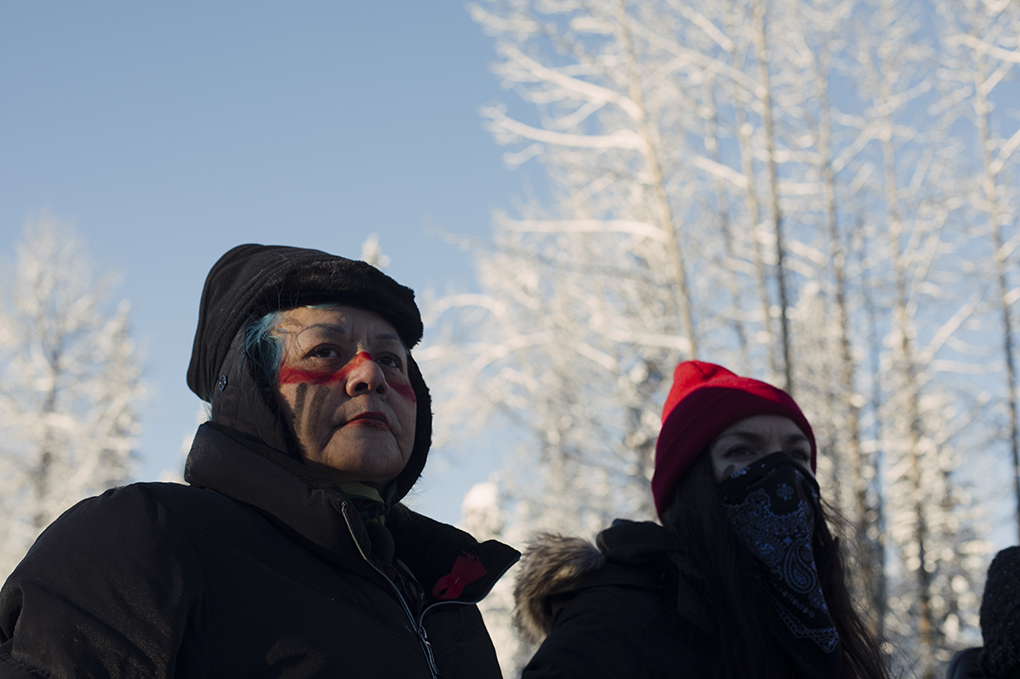
These are the relations that connect me to other Indigenous peoples as we struggle to regain ancestral skills that we have lost. These are the Indigenous assemblages that recognize our dependence on other-than-humans for our survival as peoples.
They surrounded the makeshift watchtower and the repurposed school bus where I and three other Indigenous people observed the invasion. To be clear: RCMP arrived with seventy armed officers to remove four unarmed Indigenous land defenders from the territory. They pointed snipers at us. They put tactical teams on snowshoes to surround us in the woods. They used large machinery to rip apart the gate protecting the territory. They arrested the four of us, and we spent three nights in holding cells while police tried to push release conditions that would bar us from returning to the territory. Three days later, police attacked Unist’ot’en Village, tearing three Unist’ot’en matriarchs (including Freda Huson) from their ancestral territories and arresting them along with other Indigenous supporters. The arrests violently disrupted a ceremony for missing and murdered Indigenous women and girls. Police tore down the red dresses that were hung to hold the spirits of the women and girls and extinguished the ceremonial fire.
The police raids, the arrest of Indigenous land defenders, the construction activities that proceed without consent, the surveillance and harassment — all of this indicates that pipelines are infrastructures of invasion. Pipeline infrastructures become the material through which an ongoing conquest is attempted into Indigenous lands that have never been surrendered or ceded to the colonial state. It is through these infrastructures, not only the theft and settlement of land, that Indigenous life and survival are attacked. The destructive and doomed project of resource extraction continues to fuel the colonial and capitalist states we live within. These projects parasitically drain the life-giving potential of our lands in order to feed a future climate dystopia.
Relations Against Pipelines
It has become clear to me that spaces like Unist’ot’en Village and Gidimt’en Access Point are doing more than blocking pipelines. The work of undoing colonial invasion requires blocking, resisting, and suspending the infrastructures of oil and gas. It requires building and practicing alternatives to capitalism. It also requires attending to and caring for the networks of relations that make Indigenous survival possible. These are the relations that linked my nation to the Wet’suwet’en people before our territories felt the first footsteps of white settlers. These are the relations that bring Indigenous people back onto the land and into material relation with the other-than-human beings that share their territories. These are the relations that connect me to other Indigenous peoples as we struggle to regain ancestral skills that we have lost. These are the Indigenous assemblages that recognize our dependence on other-than-humans for our survival as peoples. These are the relations threatened by invasive infrastructures and their toxic consequences. If the moose, the berry patches, the salmon, the bears are destroyed, so are we.
When Indigenous land defenders point to “our critical infrastructures,” they are pointing to another set of relations that sustains the collective life of Indigenous peoples—the human and non-human networks that have supported Indigenous communities on this continent for tens of thousands of years. Indigenous peoples reject the idea that the way of life supported by pipeline infrastructure should be accelerated or intensified and instead step into the vulnerable, volatile space between the proposal and potential completion of pipelines to protect the land, water, air, plant, and animal relations. By doing so, they protect the vital systems that form alternatives to capitalist exploitation, alternatives to oil-soaked futures, alternatives to the unquestioned occupation of the settler state. And by building alternatives based on Indigenous relations of ethics and care in the path of proposed pipeline routes, encampments like Unist’ot’en Village challenge the future destruction wrought by industry and the naturalization of colonial domination.
At Unist’ot’en Village, the hosts remind visitors, “This is not Canada, this is not British Columbia, this is unceded Wet’suwet’en territory.” If the space of the Village is not Canada today, then perhaps it is an opening to a more reciprocal Indigenous tomorrow, beyond the constant incursions of industry and colonial governments. In order to strengthen our relations against these life-threatening attacks, we must think critically about the tactics and strategies of colonial domination as they operate in pipeline construction. We can do this by supporting spaces of resistance on Wet’suwet’en territory, and by holding each other accountable for the relationship-building work that underlies everything we do. We can challenge the inevitability of colonial occupation and industrial invasion by returning to the networks that have sustained us for tens of thousands of years on our territories, and by living into better relations with each other and our other-than-human kin. We pick the berries, skin the moose, protect the water. We feed our critical infrastructures, in hopes that they will flourish again.
__
**Emphasis added. See Anne Spice,“Heal the People, Heal the Land: An Interview with Freda Huson,” in Standing with Standing Rock: Voices from the #NoDAPL Movement, eds. Jaskiran Dhillon and Nick Estes (Minneapolis: University of Minnesota Press, 2019).
Anne Spice (she/they) is a Tlingit member of Kwanlin Dun First Nation, a queer Indigenous feminist and anti-colonial organizer, Assistant Professor in the Department of Geography and Environmental Studies at Ryerson University, and an Associate Fellow at the Yellowhead Institute. They have been actively supporting the Indigenous land re-occupation in Wet’suwet’en territories since 2015, and their work dwells in the intersection of Indigenous geographies, histories and futures of Indigenous resistance, poetry and art.
Amber Bracken is a lifelong Albertan, focusing her photography across western North America. After getting her start as a staffer in daily newspapers, she now works as an independent. Select clients include National Geographic, The Globe and Mail, The Wall Street Journal, BuzzFeed, Maclean’s, ESPN, and The New York Times. Select recognition includes The World Press, The Marty Forscher Fellowship and an ICP Infinity Award. In her personal work, Amber’s interest is in the intersection of photography, journalism and public service with a special focus on stories about de-colonization. With the rise of movements like Idle No More, Indigenous communities are increasingly empowered to fight for a more just relationships with the government and non-native people. Amber has built relationships in Indigenous communities and documents important issues around culture, environment and the effects of inter generational trauma from residential schools.
All photography for this article has been sponsored by


